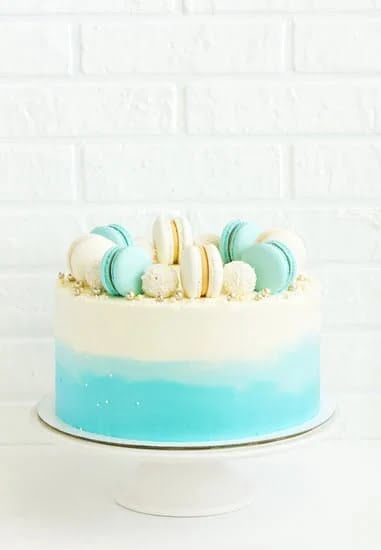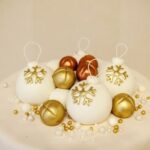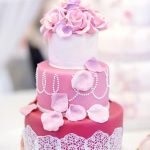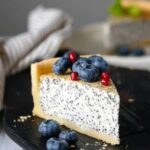Have you ever wanted to learn how to beautifully decorate cakes and create delicious frosting from scratch? Look no further. In this article, we will delve into the art of cake decoration and provide you with essential frosting recipes that are sure to impress. Whether you’re a beginner or an experienced baker, this guide will give you the knowledge and skills to create stunning and delectable cakes.
Cake decoration is not just about making your dessert look visually appealing; it’s also about showcasing your creativity and personal style. From elegant designs for special occasions to fun and whimsical creations for birthdays, there are endless possibilities when it comes to decorating cakes. In order to achieve professional-looking results, it is important to understand the fundamentals of cake decorating, including the tools, techniques, and tips that will make your cakes stand out.
But before we dive into cake decoration, it is crucial to start with a solid foundation – the perfect cake base and frosting. In this article, we will guide you step-by-step through leveling and preparing your cake for decoration. Additionally, we will share with you a foolproof buttercream frosting recipe that is velvety smooth, creamy, and versatile. We’ll also explore different types of frostings beyond buttercream and discuss their specific applications.
Whether you’re looking for inspiration or practical tips on piping techniques or using fondant for professional-looking designs, this article has got you covered. We will even show you how to add edible embellishments such as sprinkles and confetti to take your cake decorations to the next level. Finally, we’ll provide troubleshooting solutions for common challenges so that you can overcome any imperfections that may arise.
So get ready to unleash your creativity. With our comprehensive guide on cake decoration and frosting recipes at your fingertips, you’ll be able to wow your guests with beautiful and delicious creations that are truly a work of art.
Understanding the Fundamentals of Cake Decorating
When it comes to cake decorating, having the right tools can make all the difference in achieving a beautiful and professional-looking cake. Whether you are a beginner or experienced decorator, it is important to have a solid understanding of the essential tools needed for cake decorating.
Tools for Cake Decoration
In order to decorate cakes effectively, there are a few key tools that every decorator should have in their arsenal. These include:
- Piping Bags: Piping bags come in various sizes and are used to pipe frosting onto cakes in different designs and shapes.
- Decorating Tips: There are a plethora of decorating tips available that attach to piping bags to create different patterns and textures on cakes.
- Spatulas: Spatulas are incredibly versatile tools that come in different sizes and shapes. They are used for leveling frosting, smoothing edges, and creating intricate designs.
- Turntable: A turntable is a rotating platform that allows you to easily spin your cake while decorating it, making it easier to reach all sides evenly.
Techniques for Cake Decoration
Once you have gathered your tools, it is time to learn some basic techniques for cake decoration. These techniques include:
- Crumb Coating: This technique involves applying a thin layer of frosting over the entire cake to seal in any loose crumbs before adding the final layer of frosting.
- Borders: Borders add an elegant finishing touch to your cake design. Common border styles include shell borders, rosettes, or bead borders.
- Floral Designs: Flowers can give any cake a stunning presentation. Popular flowers created with frosting include roses, daisies, and tulips.
- Textures: Adding texture can bring depth and dimension to your cake design. Techniques such as ruffles or basketweave can create interesting textures.
Tips for Cake Decoration
Finally, here are a few tips to keep in mind when decorating cakes:
- Practice makes perfect: Like any skill, cake decorating requires practice. Start with simple designs and gradually work your way up to more complex ones.
- Keep it cool: Ensure that your cake is completely cooled before beginning the decoration process. Warm cakes can cause frosting to melt and ruin the design.
- Get creative: Don’t be afraid to experiment with different colors, patterns, and decorations. Let your creativity shine through and have fun with the process.
By understanding the fundamentals of cake decorating, including the necessary tools, techniques, and tips, you will be well-equipped to create beautiful, professional-looking cakes that are sure to impress your friends and family.
Step-by-Step Guide to Leveling and Preparing Your Cake for Decoration
When it comes to decorating a cake, one of the most important steps is ensuring that your cake is properly leveled and prepared. This will not only make it easier to decorate, but also ensure that your finished product looks clean and professional. In this section, we will provide you with a step-by-step guide on how to level and prepare your cake for decoration.
Firstly, you will need the right tools for this task. A long serrated knife or a cake leveler can be used to trim off the domed top of the cake, creating an even surface. Additionally, a turntable is recommended as it allows for easier access and smooth rotations while working on the cake.
To begin, place the cooled cake on a sturdy surface or a turntable. If there are any uneven bumps or edges on the top of your cake, gently press down on them with your hand.
Next, using a long serrated knife or a cake leveler, carefully slice off the domed top of the cake in a sawing motion. Be sure to keep your hand steady and maintain an even pressure while cutting. Rotate the cake as needed to ensure an even cut all around.
Once you have leveled off the top of the cake, it’s important to remove any loose crumbs from its surface. This can be done by lightly brushing away any excess crumbs with a pastry brush or by using a clean kitchen towel.
Now that you have leveled and cleaned your cake, it is ready to be frosted and decorated according to your desired design. Remember to use an offset spatula or a butter knife for applying frosting evenly over the surface of the cake.
| Tools | Steps |
|---|---|
| A long serrated knife or a cake leveler | Trim off domed top of cake |
| Turntable | Place the cake for easy access and smooth rotations |
| Pastry brush or clean kitchen towel | Remove loose crumbs from cake surface |
| Offset spatula or butter knife | Apply frosting evenly over the cake surface |
Mastering the Art of Perfect Buttercream Frosting
What is Buttercream Frosting?
Buttercream frosting is a versatile and delicious frosting that is commonly used to decorate cakes. It is made from a combination of butter, powdered sugar, vanilla extract, and milk or cream. The result is a smooth and creamy frosting that can be easily tinted with food coloring for a variety of decorative effects. Buttercream frosting is not only easy to make but also allows for endless creativity when it comes to cake decoration.
A Foolproof Buttercream Recipe
To create the perfect buttercream frosting, follow this foolproof recipe:
Ingredients:
- 1 cup unsalted butter (2 sticks), softened.
- 4 cups powdered sugar.
- 1 tablespoon vanilla extract.
- 2-3 tablespoons milk or cream.
Instructions:
- In a large bowl, beat the softened butter with an electric mixer on medium speed until creamy and smooth.
- Gradually add the powdered sugar, one cup at a time, beating well after each addition.
- Add the vanilla extract and mix until well combined.
- Gradually add the milk or cream, one tablespoon at a time, until the desired consistency is reached. Continue beating until light and fluffy.
- If you want to tint your buttercream frosting with food coloring, add it in small amounts until you achieve the desired shade.
- Now your homemade buttercream frosting is ready to use for decorating your cake.
Tips for Working With Buttercream Frosting
Working with buttercream frosting requires some practice and patience to achieve beautiful results. Here are some tips to keep in mind:
- Soften the butter: Make sure your butter is soft but not melted before starting to make the frosting. This will ensure a smooth texture without any lumps.
- Gradually add powdered sugar: Adding powdered sugar gradually will prevent clumps from forming and make it easier to achieve a smooth consistency.
- Adjust the consistency: The amount of milk or cream you add will determine the consistency of your buttercream frosting. For spreading and filling purposes, a thicker consistency is preferable, while for piping delicate designs, a softer consistency is better.
- Chill before piping: If you’re planning to pipe intricate designs with your buttercream frosting, chill it in the refrigerator for about 15-20 minutes before transferring it to a piping bag. This will make it firmer and more manageable when working with intricate details.
By following this foolproof buttercream frosting recipe and keeping these tips in mind, you’ll be well on your way to creating beautifully decorated cakes that are sure to impress. Experiment with different colors, textures, and piping techniques to unleash your creativity and wow your guests.
Beyond Buttercream
Frosting is a crucial element of cake decoration, and while buttercream is the classic choice, there are many other types of frosting that can elevate your cakes to the next level. In this section, we will explore different types of frosting and their applications, providing you with a delicious array of options to experiment with.
Cream Cheese Frosting
Cream cheese frosting is a rich and tangy option that pairs well with a variety of cake flavors. Its creamy texture makes it easy to spread and pipe, making it an ideal choice for both filling and covering cakes. This frosting is particularly popular for carrot cakes and red velvet cakes, as the slight tanginess complements their flavors perfectly.
Whipped Cream Frosting
Light and fluffy, whipped cream frosting adds a delicate touch to any cake. It is made by whipping heavy cream until stiff peaks form, then sweetening it with sugar or powdered sugar. Whipped cream frosting goes well with fruit-flavored cakes or light sponge cakes. Keep in mind that this type of frosting has a shorter shelf life compared to other frostings due to the perishable nature of whipped cream.
Ganache
Ganache is a luscious combination of chocolate and cream that can be used as both a filling and a glaze for cakes. It can create a smooth and glossy finish on your cake, giving it an elegant appearance.
Ganache can be made using different ratios of chocolate to cream, which will result in varying consistencies – from pourable ganache to thicker spreadable ganache. Dark chocolate ganache pairs well with rich chocolate cakes, while milk or white chocolate ganache complements lighter flavors like vanilla or coconut.
Meringue Buttercream
Meringue buttercream is light yet decadent, made by combining Italian or Swiss meringue with butter. This frosting has a silky smooth texture and holds up well in warm weather, making it an excellent choice for tiered cakes or outdoor events. The meringue adds stability and makes the buttercream less sweet compared to traditional buttercream. Meringue buttercream is versatile and can be flavored with various extracts or fruit purees, allowing for endless flavor combinations.
Exploring different types of frosting opens up a world of creativity in cake decoration. Experiment with these recipes to find the perfect frosting to complement your cake’s flavors and design. Remember, you can always mix and match frostings to create unique combinations that will impress both visually and on the palate. The possibilities are endless, so don’t be afraid to let your imagination run wild.
Inspiring Cake Decoration Ideas
Cake decoration is not just about making your dessert look visually appealing, it’s also an opportunity to showcase your creativity and add a personal touch. In this section, we will explore inspiring cake decoration ideas that range from simple designs to showstoppers. Whether you’re a novice or an experienced baker, these ideas will help you take your cake decorating skills to the next level.
1. Floral Delights: Flowers are a classic choice for cake decoration and can instantly elevate the overall look of your creation. From delicate roses to vibrant sunflowers, there are endless possibilities when it comes to floral designs. Consider piping buttercream flowers directly on the cake or using edible fondant or gum paste flowers for a more realistic effect.
2. Geometric Elegance: For a modern and sophisticated cake design, try incorporating geometric patterns into your decoration. Use stencils or cutters to create clean lines and shapes on the surface of your cake. Experiment with different colors and textures to add flair and dimension to your design.
3. Whimsical Themes: Let your imagination run wild by choosing a whimsical theme for your cake decoration. From fairy tales to animals, you can bring any concept to life with the right tools and techniques. Use fondant or modeling chocolate to sculpt figurines or recreate scenes on top of your cake for a fun and playful touch.
4. Naked Cakes: Less is more with naked cakes, which have gained popularity in recent years for their rustic charm. Instead of completely covering the cake with frosting, leave some edges exposed for a natural and organic look. Decorate with fresh fruits, flowers, or dustings of powdered sugar for added elegance.
Pro Tip: Don’t be afraid to mix and match different decoration techniques and ideas. Combining elements such as piping, fondant work, and edible embellishments can create truly unique and eye-catching designs.
Remember, the most important thing is to have fun and let your creativity shine through. Experiment with different ideas and techniques to find your own personal style. Whether you’re making a cake for a special occasion or simply for the joy of baking, these inspiring decoration ideas will surely impress your guests and make your dessert the centerpiece of any celebration.
Tips and Tricks for Piping Techniques
Piping techniques are an essential skill for any cake decorator. Whether you want to create intricate borders, beautiful flowers, or add textures to your cakes, mastering piping can take your cake decorating skills to the next level. Here are some tips and tricks to help you create stunning designs with piping.
- Choosing the right piping tips: The type of piping tip you use will determine the shape and size of the design. Start with a basic set that includes round tips for borders, star tips for rosettes and swirls, and petal tips for flowers. As you advance, you can invest in more specialized tips to expand your repertoire.
- Consistency is key: The consistency of your frosting or icing is crucial when it comes to piping. If it’s too thick, it will be difficult to pipe smoothly; if it’s too thin, the design may lose its shape. Aim for a medium consistency that holds its form but is still pliable enough to pipe easily.
- Practice makes perfect: Piping requires precision and control, which can only be achieved through practice. Start by practicing basic designs on parchment paper or a silicone mat before moving onto cakes. This will help you get a feel for different pressure techniques and develop muscle memory.
- Holding the piping bag: Properly holding the piping bag is essential for achieving clean and consistent designs. Hold the bag firmly with one hand while using the other hand to guide and control the direction of the piping tip.
- Adding depth with layers: To create depth in your designs, consider layering different colors or shades of frosting. For example, start with a base layer in one color and then add details in a contrasting shade on top.
- Embracing textures: Piping isn’t just about creating smooth lines; it’s also an opportunity to add texture and dimension to your cakes. Experiment with different techniques such as ruffles, shells, basketweave, or stenciling to create unique and eye-catching designs.
Remember, practice and patience are key when it comes to mastering piping techniques. Don’t be discouraged if your first attempts don’t turn out as expected – keep practicing and experimenting, and soon you’ll be creating professional-looking cake decorations that will impress everyone who sees them.
Taking it to the Next Level
Fondant icing is a versatile and popular choice for cake decoration, known for its smooth, flawless finish. Whether you’re looking to create an elegant wedding cake or a whimsical birthday cake, fondant allows you to achieve professional-looking results. In this section, we will explore the basics of working with fondant and provide tips on how to use it effectively.
To start using fondant for cake decoration, you’ll need a few essential tools. A rolling pin is crucial for rolling out the fondant to the desired thickness. It’s recommended to use a non-stick rolling pin or one that can be lightly dusted with powdered sugar to prevent sticking.
A sharp knife or pizza cutter is handy for trimming excess fondant once it’s draped over the cake. Additionally, it’s helpful to have a smoother tool made specifically for fondant that will help eliminate any wrinkles or air bubbles when applying the icing.
Before applying fondant to your cake, ensure that your buttercream frosting has been chilled and smoothed as much as possible. This will create a smooth base and help the fondant adhere better. It’s always a good idea to lightly brush your frosted cake with simple syrup or water before adding the fondant; this will act as an adhesive and prevent air bubbles from forming.
Once your preparations are complete, roll out your fondant on a clean surface dusted with powdered sugar or cornstarch. Roll it until it is large enough to cover your entire cake without stretching too much. Gently lift the rolled-out fondant onto the cake and begin smoothing it from top to bottom and around the sides using a smoother tool. Trim off any excess at the base of the cake using a sharp knife or pizza cutter.
Working with fondant requires practice and patience, so don’t be discouraged if you don’t achieve perfection right away. The more you work with it, the more comfortable you’ll become in manipulating and shaping it to create various designs. With time and practice, you’ll be able to create professional-looking cakes that will impress your guests.
In the next section, we will explore different types of edible embellishments that can be added to your cake decoration, including sprinkles, confetti, and creative toppings. These elements can bring an extra touch of creativity and flair to your fondant-covered cake.
Decorating with Edible Embellishments
No cake decoration is complete without adding some extra pizzazz with edible embellishments. Sprinkles, confetti, and creative toppings can instantly transform a plain cake into a vibrant and eye-catching masterpiece. In this section, we will explore different types of edible embellishments and provide ideas on how to use them effectively in your cake decoration.
Here are some popular types of edible embellishments that you can consider using:
- Sprinkles: Sprinkles come in various shapes, sizes, and colors, making them a versatile choice for adding a touch of whimsy to your cake. Whether you opt for classic rainbow-colored sprinkles or themed sprinkles for special occasions like birthdays or holidays, they are an easy way to enhance the visual appeal of your cake.
- Confetti: Edible confetti is another fantastic option for creating a festive look on your cake. These tiny edible shapes often come in fun themes like hearts, stars, or seasonal motifs. Simply sprinkle them over the frosting or arrange them strategically to create patterns or designs.
- Creative Toppings: Get creative with toppings by utilizing ingredients such as crushed nuts, chocolate shavings, coconut flakes, or fresh fruits like berries. These unique toppings can add texture and flavor while making your cake aesthetically pleasing.
When it comes to applying these edible embellishments on your cakes, there are several ways you can do so:
- Sprinkle Method: For small sprinkles or confetti shapes, simply hold them over the frosted cake and gently shake them out onto the surface until desired coverage is achieved. You can also use a spoon to scatter larger sprinkles or create specific patterns.
- Pressing in Method: Some creative toppings may need to be pressed into the frosting slightly for better adhesion. Use clean hands or a spatula to gently press ingredients like crushed nuts or coconut flakes into the sides or top of the cake.
- Controlled Placement: If you have a specific design or pattern in mind, consider using tweezers or a toothpick to place individual edible embellishments precisely where you want them. This method works well for creating custom designs or adding intricate details.
Remember, the key to successful cake decoration with edible embellishments is to strike the right balance between visual appeal and taste. Be mindful of flavors and textures when choosing your toppings, ensuring they complement both the frosting and cake itself. With a little creativity and experimentation, you can create stunning cakes that not only look amazing but also delight the taste buds of everyone who indulges in a slice.
Final Touches of Elegance
When it comes to cake decoration, the final touches are what elevate a cake from ordinary to extraordinary. Adding finishing touches not only enhances the overall appearance of the cake but also provides an opportunity for personalization and creativity. In this section, we will explore various ways to add those final elegant touches to your cakes.
One popular way to add elegance to a cake is by using edible flowers or fresh fruit as decorative elements. Edible flowers can be used to create stunning floral arrangements on top of the cake or as individual accents around the edges. Fresh fruit, such as berries or slices of citrus, can be strategically placed on the cake to add color and freshness.
Another way to enhance the look of your cake is by adding intricate piping details. Piping is a technique that involves using a piping bag and different tips to create decorative patterns and designs. You can pipe borders, flowers, swirls, or even write personalized messages on your cakes. Experimenting with different piping techniques and designs allows you to showcase your creativity and add a professional touch.
Personalizing your cake is another way to make it stand out. One option is to use edible ink pens or food coloring markers to write names, messages, or draw custom designs directly onto the cake’s surface. Another idea is to create custom cake toppers using fondant or gum paste. These personalized touches not only make the cake unique but also show that it was made with love and care.
| Idea | Description |
|---|---|
| Edible Flowers | Use edible flowers as decorative elements for an elegant look. |
| Fruit Decorations | Add fresh fruit like berries or citrus slices for color and freshness. |
| Piping Details | Experiment with different piping techniques to create intricate designs. |
| Edible Ink Pens | Write personalized messages or draw custom designs using edible ink pens. |
| Custom Cake Toppers | Create personalized cake toppers using fondant or gum paste. |
Remember, the final touches of elegance should reflect your style and the occasion. Whether it’s a birthday, wedding, or any other celebration, adding these finishing touches will not only make your cake visually appealing but also leave a lasting impression on your guests. So unleash your creativity and have fun decorating.
Troubleshooting Common Cake Decoration Challenges
Cake decoration can be a fun and rewarding process, but sometimes things don’t go as planned. In this section, we will address some common cake decoration challenges and provide solutions to help you fix any imperfections that may arise.
One common challenge is uneven frosting or icing. This can happen when the cake isn’t evenly leveled or if the frosting isn’t spread evenly across the surface. To fix this, start by using a long serrated knife to level the cake layers if needed.
Then, apply a crumb coat – a thin layer of frosting that acts as a base – before adding the final layer. Use an offset spatula to smooth out any uneven areas and create a clean finish.
Another challenge is air bubbles in your fondant or buttercream. These can create unsightly bulges or gaps in your design. To prevent air bubbles, make sure to roll out your fondant evenly and smoothly so there are no trapped pockets of air. If you do encounter air bubbles, try using a pin or needle to gently prick them and smooth out the area with your fingers.
One more common challenge is getting vibrant colors for your decorations. Sometimes, the colors turn out dull or muted instead of bright and vibrant. To achieve vibrant colors, it’s important to use gel food coloring rather than liquid food coloring which can dilute the intensity of the color. Start with small amounts of coloring and gradually add more until you achieve your desired shade.
| Common Challenge | Solution |
|---|---|
| Uneven Frosting | Level the cake layers, apply a crumb coat, spread frosting evenly |
| Air Bubbles in Fondant/Buttercream | Roll out fondant smoothly, prick air bubbles with a pin, smooth out the area |
| Dull Colors | Use gel food coloring, start with small amounts and gradually add more for vibrant shades |
By addressing these common cake decoration challenges, you can ensure that your creations look both beautiful and delicious. Don’t be discouraged if you encounter imperfections along the way – with the right solutions and a bit of practice, you’ll be able to troubleshoot and create stunning cakes that will impress your guests.
Conclusion
In conclusion, cake decoration is truly an art form that allows you to express your creativity and impress your guests with beautiful and delicious creations. With the knowledge and skills gained from this article, you are well-equipped to embark on your cake decorating journey.
By understanding the fundamentals of cake decorating, mastering various frosting techniques, and exploring different types of frostings and their applications, you have the tools needed to create stunning cakes for any occasion. Whether you prefer simple designs or showstopping masterpieces, the ideas presented in this article will surely inspire you.
Furthermore, the tips and tricks for piping techniques, using fondant, and decorating with edible embellishments provide opportunities for adding unique touches to your cakes. By experimenting with different techniques and finishes, you can truly personalize each cake and make it a memorable centerpiece.
Finally, remember that perfection is not always necessary when it comes to cake decorating. In the troubleshooting section of this article, solutions to common challenges are provided because even professionals encounter imperfections. The most important thing is to embrace your creativity and enjoy the process of creating something beautiful.
So go ahead, unleash your creativity, and wow your guests with these cake decoration and frosting recipes. Whether it’s a birthday celebration or a special event, let your cakes be a reflection of your artistic abilities and bring joy to everyone who indulges in them. Happy decorating.
Frequently Asked Questions
What kind of frosting is used to decorate cakes?
The most common type of frosting used to decorate cakes is buttercream frosting. Buttercream frosting is made by combining butter, powdered sugar, and flavorings such as vanilla extract, and it has a smooth and creamy texture.
It can be flavored with different extracts or food coloring to add variety and is often used for piping decorations like borders, flowers, and writing on cakes. Buttercream frosting provides a sweet taste and acts as a canvas for further decorations.
How to decorate a cake with frosting?
Decorating a cake with frosting involves several steps to achieve an attractive and professional finish. First, you need to crumb coat the cake by spreading a thin layer of frosting all over its surface. This helps seal the crumbs before applying the final layer of frosting. Next, using an offset spatula or a piping bag fitted with a nozzle, apply a thicker layer of frosting onto the cake in smooth and even strokes.
Start from the top, moving towards the sides until the entire cake is covered in frosting. To create decorative patterns or designs, you can use various piping techniques such as rosettes, stars, or borders. Finish off your creation by adding any additional decorations such as sprinkles, edible pearls, or fresh fruits.
What are the steps to decorate a cake?
The steps involved in decorating a cake can vary depending on personal preference and desired design. However, there are some general steps that apply to most cases. Firstly, ensure that your cake is cooled completely before starting any decoration process to avoid melting or misshaping the decorations. Then carefully level and trim any uneven parts of the cake layers if necessary so that they stack evenly.
Once you have assembled the layers with your preferred filling (if any), proceed to apply your chosen frosting using techniques mentioned earlier – such as crumb coating followed by final coating and smoothing it out on all sides using an offset spatula or bench scraper for clean edges. Finally, let your creativity shine through as you add personalized touches like piped decorations, designs, or any other elements that make your cake unique and visually appealing. The key is to take your time, be patient, and have fun while letting your artistic skills guide you through the process.

Welcome to our cake decorating blog! My name is Destiny Flores, and I am the proud owner of a cake decorating business named Cake Karma. Our mission is to provide delicious, beautiful cakes for all occasions. We specialize in creating custom cakes that are tailored specifically to each customer’s individual needs and tastes.





